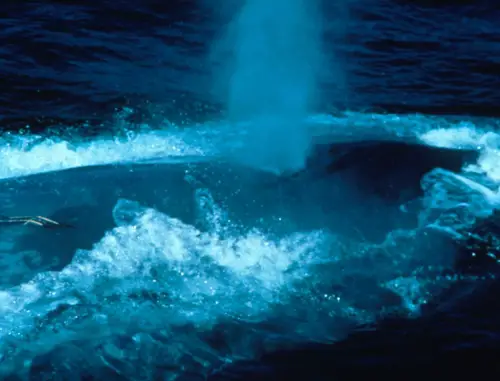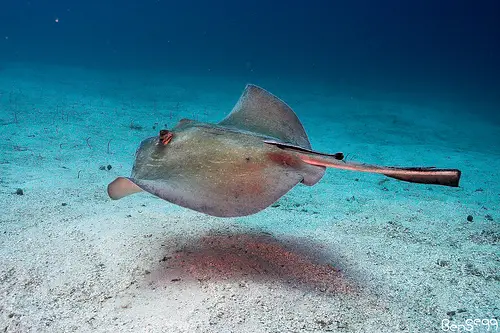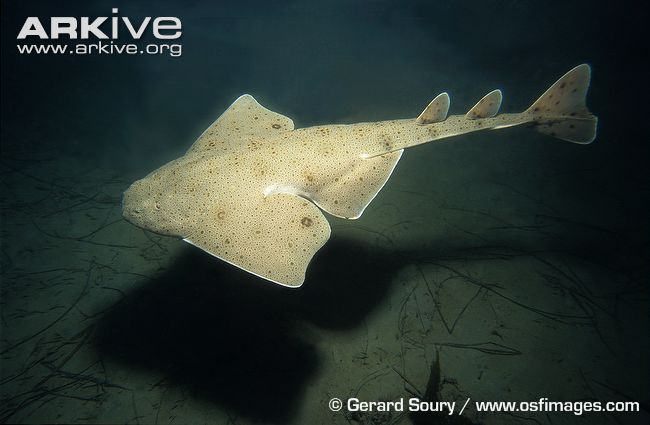Blue Whale
The Blue Whale is what is known as a baleen whale, a mammal, that can grow up to 110 feet long and weigh about two hundred tons.
It is thought to be the largest animal to have ever lived.
As tall as a tree if it were stood upright, the blue whale comes in various colors of blue and gray, with a lighter underbelly.
With all baleen whales they are possessed of no teeth, but a grate like object in their mouth through which they strain sea water to gain the krill, small crustaceans, fish and once in a while squid that enter their mouths.

A blue whale and its calf migrating
Blue whale once roamed the oceans in huge groups, until the beginning of the twentieth century, when they began to be hunted for bone, meat and oil. For nearly forty years they were hunted almost to the brink of extinction, by the whaling ships, until finally in the mid 1960’s the international community called a halt to it.
In 2002 a report issued suggested that only an estimated 5 to 20 thousand whales existed world wide of the Blue Whale species, separated into about five groups of whales however new research shows that this data may be incorrect.
Before whaling the largest population was in the Antarctic, numbering approximately 239,000
In the Antarctic, there are only very small groups and a much smaller concentration of the whales than there once was.
There remain only much smaller (around 2,000) concentrations in each of the North-East Pacific, Antarctic, and Indian Ocean groups. There are two more groups in the North Atlantic and at least two in the Southern Hemisphere.

A Blue whale spouting through the blowhole
Blue Whales are difficult to weigh because of their size.
Most Blue Whales killed by whalers were not weighed whole, but cut up into manageable pieces first. This caused an underestimate of the total weight of the whale, due to the loss of blood and other fluids.
Regardless of this they have been weighed, minus that fluid at over 190 tons and with a 98 foot length.
The largest Blue Whale accurately weighed by scientists to date was a female that weighed 177 tonnes.
Blue Whales feed almost exclusively on krill, though they also take small numbers of copepods.
The whales always feed in the areas with the highest concentration of krill, sometimes eating up to (8,000 lb of krill in a single day.
The blue whale will mate in late autumn, and continue mating til the end of winter time.
Very little is known about their mating habits or the breeding grounds, however they do give birth to one, or very rarely two calves, every two or three years after a gestation period of ten to twelve months.
The baby whale, called a calf weighs about two and a half tons and is around 7 m (23 ft) long when it is born.
This small infant will drink about 125 gallons of milk in a single day, from the mother whale.
Her milk is very high in fat and the baby blue will grow as much as 200 pounds of body weight in a single day.
At about six months old they are weaned but still remain with the mother whale.
Scientists estimate that Blue Whales can live for at least 80 years.
Blue Whale strandings are extremely uncommon, and, because of the species’ social structure, mass strandings are unheard of.



facts:- an average calf whale ganes upto 100kg/day because of whales nutritious milk . it is rich in fat and contains 35% more fat content in comparision of milk we drink! the baby of blue whale weights around six-eight tons at birth while the baby of a sperm whale weights up to a ton!!!
Blue whales are gorgeous animals, eventhough they are the biggest animals yet discovered on earth, they have a huge life span!!
Longer then some humans can even live up to.
Save the blue whales!
I agreee. But they are endangered.
we should the blue whales there amazing animals